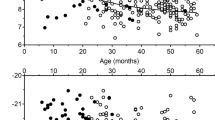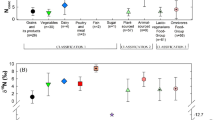Abstract
Since exclusively breast-suckled infants obtain their nutrient only from their mother’s milk, it might be anticipated that a correlation will exist between the 15N/14N isotope ratios of amino acids of protein of young infants and those supplied by their mother. The work presented here aimed to determine whether amino nitrogen transfer from human milk to infant hair protein synthesized within the first month of life conserves the maternal isotopic signature or whether post-ingestion fractionation dominates the nitrogen isotope spectrum. The study was conducted at 1 month post-birth on 100 mother–infant pairs. Isotope ratios 15N/14N and 13C/12C were measured using isotope ratio measurement by Mass Spectrometry (irm-MS) for whole maternal milk, and infant hair and 15N/14N ratios were also measured by GC-irm-MS for the N-pivaloyl-O-isopropyl esters of amino acids obtained from the hydrolysis of milk and hair proteins. The δ15N and δ13C (‰) were found to be significantly higher in infant hair than in breast milk (δ15N, P < 0.001; δ13C, P < 0.001). Furthermore, the δ15N (‰) of individual amino acids in infant hair was also significantly higher than that in maternal milk (P < 0.001). By calculation, the observed shift in isotope ratio was shown not to be accounted for by the amino acid composition of hair and milk proteins, indicating that it is not simply due to differences in the composition in the proteins present. Rather, it would appear that each pool—mother and infant—turns over independently, and that fractionation in infant N-metabolism even in the first month of life dominates over the nutrient N-content.

Similar content being viewed by others
Abbreviations
- EA:
-
Elemental analyser
- GA:
-
Gestational age
- irm:
-
Isotope ratio measurement
- MS:
-
Mass spectrometry
- Nleu:
-
Norleucine
- Vs:
-
‘Area All’ output of the mass spectrometer
- Xle:
-
Mixture of leucine and isoleucine
References
Barker DJP, Winter PD, Osmond C, Margetts B, Simmonds SJ (1989) Weight in infancy and death from ischaemic heart disease. Lancet 2:577–580
Barker DJP, Osmond C, Forsén TJ, Kajantie E, Eriksson JG (2005) Trajectories of growth among children who have coronary events as adults. New Engl J Med 353:1802–1809
Botton J, Heude B, Maccario J, Ducimetiere P, Charles M (2008) Postnatal weight and height growth velocities at different ages between birth and 5 y and body composition in adolescent boys and girls. Am J Clin Nutr 87(6):1760–1768
Carratù B, Boniglia C, Scalise F, Ambruzzi AM, Sanzini E (2003) Nitrogenous compounds of human milk: non-protein nitrogen, true protein and free amino acids. Food Chem 81:357–362
Davis TA, Nguyen HV, Garcia-Bravo R, Fiorotto ML, Jackson EM, Lewis DS, Lee DR, Reeds PJ (1994) Amino acid composition of human milk is not unique. J Nutr 124:1126–1132
de Luca A, Boisseau N, Tea I, Louvet I, Robins RJ, Forhan A, Charles M-A, Hankard R (2012) 15N content in hair from newborn infants and their mothers: a cohort study. Pediatr Res 71:598–604
Fuller BT (2003) Isotopic investigation of pregnancy and breastfeeding in modern and archaeological populations. Oxford, Oxford
Fuller BT, Fuller JL, Sage NE, Harris DA, O’Connell TC, Hedges RE (2004) Nitrogen balance and δ15N: why you’re not what you eat during pregnancy. Rapid Commun Mass Spectrom 18:2889–2896
Fuller BT, Fuller JL, Sage NE, Harris DA, O’Connell TC, Hedges RE (2005) Nitrogen balance and δ15N: why you’re not what you eat during nutritional stress. Rapid Commun Mass Spectrom 19:2497–2506
Fuller B, Fuller J, Harris D, Hedges R (2006) Detection of breastfeeding and weaning in modern human infants with carbon and nitrogen stable isotope ratios. Am J Phys Anthropol 129:279–293
Hatch K, Crawford M, Kunz A, Thomsen S, Eggert D, Nelson S, BL R (2006) An objective means of diagnosing anorexia nervosa and bulemia nervosa using 15N/14N and 13C/12C ratio in hair. Rapid Commun Mass Spectrom 20:3367–3373
Koletzko B, von Kries R, Closa R, Escribano J, Scaglioni S, Giovannini M, Beyer J, Demmelmair H, Gruszfeld D, Dobrzanska A, Sengier A, Langhendries JP, Rolland Cachera MF, Grote V, European Childhood Obesity Trial Study Group (2009) Lower protein in infant formula is associated with lower weight up to age 2 y: a randomized clinical trial. Am J Clin Nutr 89:1836–1845
Lehn C, Haas-Gebhard B, Graw M, Rossmann A, Rummel S, Hölzl S, Fuller BT, Petzke KJ (2012) Was Rosalinde a pregnant foreigner? Isotope analysis of H, C, N, S and Sr in hair strands of a late medieval bog body from Upper Bavaria. In: Paper presented at the JESIUM 2012, Leipzig, UFZ conference centre ‘Leipziger KUBUS’, Germany, September 2–7, 2012
Mamelle N, Munoz F, Grandjean H (1996) Fetal growth from the AUDIPOG study. I. Establishment of reference curves. J Gynecol Obstet Biol Reprod (Paris) 25:61–70
Petzke KJ, Fuller BT (2012) 15N and 13C abundances of individual amino acids of hair during pregnancy. In: Paper presented at the JESIUM 2012, Leipzig, UFZ conference centre ‘Leipziger KUBUS’, Germany, September 2–7, 2012
Petzke KJ, Lemke S (2009) Hair protein and amino acid 13C and 15N abundances take more than 4 weeks to clearly prove influences of animal protein intake in young women with a habitual daily protein consumption of more than 1 g per kg body weight. Rapid Commun Mass Spectrom 23:2411–2420
Petzke KJ, Boeing H, Klaus S, Metges CC (2005) Carbon and nitrogen stable isotopic composition of hair protein and amino acids can be used as biomarkers for animal-derived dietary protein intake in humans. J Nutr 135(6):1515–1520
Petzke K, Feist T, Fleig W, Metges C (2006) Nitrogen isotopic composition in hair protein is different in liver cirrotic patients. Rapid Commun Mass Spectrom 20:2973–2978
Petzke K, Fuller B, Metges C (2010) Advances in natural stable isotope ratio analysis of human hair to determine nutritional and metabolic status. Curr Opin Clin Nutr Metab Care 13:532–540
Ravelli AC, van der Meulen JH, Michels RP, Osmond C, Barker DJ, Hales CN, Bleker OP (1998) Glucose tolerance in adults after prenatal exposure to famine. Lancet 351:173–177
Reilly J, Armstrong J, Dorosty A, Emmett P, Ness A, Rogers I et al (2005) Early life risk factors for obesity in childhood: cohort study. Br Med J 330:1357
Rolland Cachera MF, Deheeger M, Akrout M, Bellisle F (1995) Influence of macronutrients on adiposity development: a follow up study of nutrition and growth from 10 months to 8 years of age. Int J Obes Relat Metab Disord 19:573–578
Tea I, Le Gall G, Küster A, Guignard N, Alexandre-Gouabau M-C, Darmaun D, Robins RJ (2012) 1H-NMR-based metabolic profiling of maternal and umbilical cord blood indicates altered materno-foetal nutrient exchange in preterm infants. PloS One 7:e29947
Tea I, Le Guennec A, Frasquet-Darrieux M, Julien M, Romek K, Antheaume I, Hankard R, Robins RJ (2013) Simultaneous determination of natural-abundance δ15N values and quantity of individual amino acids in proteins from milk of lactating women and from infant hair using gas chromatography-isotope ratio measurement by mass spectrometry. Rapid Commun Mass Spectrom 27:1345–1353
Acknowledgments
We are most grateful to those mothers who consented to partake in this study. This work was in part funded by the Inter-regional project PHRC 2009 No 23-4 (REGULACT). The funders had no role in study design, data collection and analysis, decision to publish, or preparation of the manuscript.
Conflict of interest
All authors declare that they have no conflict of interest.
Author information
Authors and Affiliations
Corresponding author
Electronic supplementary material
Below is the link to the electronic supplementary material.
Rights and permissions
About this article
Cite this article
Romek, K.M., Julien, M., Frasquet-Darrieux, M. et al. Human baby hair amino acid natural abundance 15N-isotope values are not related to the 15N-isotope values of amino acids in mother’s breast milk protein. Amino Acids 45, 1365–1372 (2013). https://doi.org/10.1007/s00726-013-1597-7
Received:
Accepted:
Published:
Issue Date:
DOI: https://doi.org/10.1007/s00726-013-1597-7




